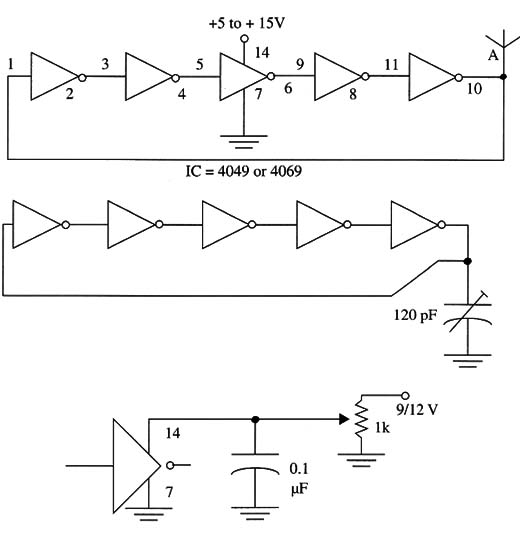Features
Range: 1 to 3 ft
Frequency range: 100 kHz to 4 MHz
Power supply voltage: 3 to 12 Vdc
Number of components: 1
This experimental transmitter uses only one CMOS integrated circuit and can produce radio frequency noise in a wide range of the LW, MW, and SW bands.
Its signals can be tuned in by any AM or SW receiver in the form of a noise that proves that digital circuits can produce radio signals.
Other uses to this transmitter are
Short-range telegraphic communications, sending signals through a wall
As a signal injector to test and adjust radio receivers in the MW and SW bands
To produce interference in radio receivers for counterespionage
The circuit can be powered from power supplies ranging from 3 to 12 V, and all the reader needs to put this device on the air is a length of plastic-covered wire as an antenna and, optionally, a length of the same wire as a ground connection.
How It Works
The inverters found in a 4049 or 4069 CMOS integrated circuit are wired as a ring oscillator. The propagation time of the signal through each inverter determines the time of a complete cycle of the resultant signal and therefore the frequency.
Notice that each stage of the circuit inverts the signal so, to obtain oscillations, an odd number of them must be used. The ideal number to keep the circuit in a state of oscillation is three or five.
This means that it is not necessary to use external elements to set the frequency or to generate the feedback that is required to put the circuit in oscillation.
As the propagation time of a signal in a CMOS circuit depends on the power supply voltage, this element can be used to tune the signal.
Thus, we have fixed-frequency version in which the signal frequency is fixed by the power supply voltage, and a variable-frequency version that includes elements to change this parameter.
As the circuit produces a square wave that is rich in harmonics, it is possible to tune to it at many points in the radio band. Therefore, if it is adjusted to a frequency of about 100 kHz, the signals can be picked up at point separated by 100 kHz from this frequency to up to 10 MHz and beyond.
Th reader can locate the frequency at which the signal power is highest and use it fo the experiments.
Assembly
Figure 1 shows three basic versions of this transmitter.

The first circuit (top) is a fixed-frequency unit in which the power supply voltage determines the signal frequency in the range of 100 kHz to 4 MHZ.
The second and third circuits employ added elements that can be used to change the frequency without changing the power supply voltage. All versions can be mounted on a solderless board or breadboard, as they are experimental.
The output power produced by this circuit is very low (a few milliwatts), but the transmission can be picked up in a receiver placed several feet away from it.
The reader can wire a Morse key in series with the power supply for sending CW signals.
The operational range with a 6 V supply is between 1 and 3 MHz. An antenna can be connected to the circuit to increase the output power. A piece of plastic-covered wire 3 to 10 ft long makes a good antenna for this circuit.
Using the Circuit
There are no adjustments required for this circuit except in the variable frequency versions. Place any receiver tuned to a free point in the MW or SW band and turn on the transmitter.
Then locate the signal in the band, adjusting the power supply voltage if necessary. If the circuit is used in science demonstrations, you can use
it to illustrate how electromagnetic waves are generated.
Semiconductors
IC1 - 4049 or 4069 CMOS integrated circuit
Miscellaneous
Solderless board, Wires, power supply, antenna, additional components for the
variable-frequency versions.




